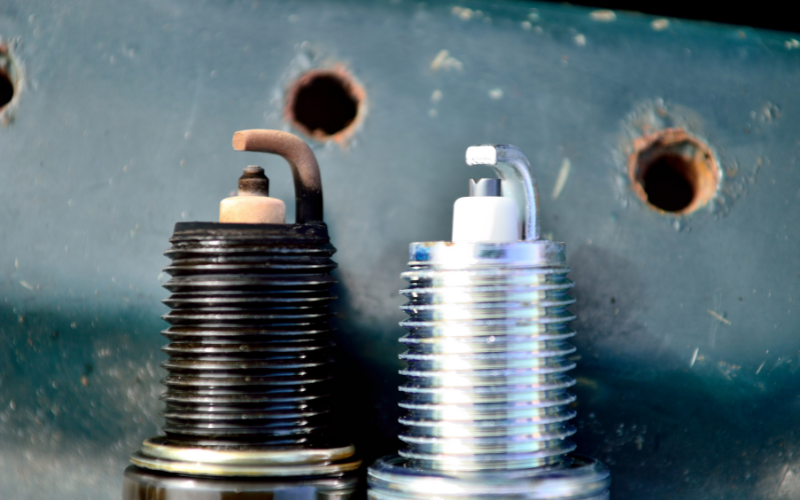Most people have stumbled across the topic of spark plugs and their gap at some point in time whether during a conversation with a neighbor, family member, or mechanic friend. This was something that happened to me and left me wondering, what exactly is a lawn mower spark plug gap? I already knew that the main job of spark plugs was to ignite the fuel and air mix that enters the engine but wasn’t sure what exactly the gap refers to on a spark plug. After doing some digging, I think I’ve figured it out. Let’s get into it.

What is the Gap on a Lawn Mower Spark Plug?
A lawn mower’s spark plug gap is the tiny space in between the center electrode and ground electrode at the very tip of the spark plug. The ground electrode is really easy to identify because it is the curved metal piece that extends from the threads on the spark plug. The center electrode is a little bit more hidden because it runs through the middle of the spark plug and sticks out right under the ground electrode. This end of the spark plug sits just inside the engine cylinder and is where the spark is created.
What Does the Mower Spark Plug Gap Do?
The gap on a spark plug is where the arcing, or spark, actually occurs. This spark happens when electricity from the ignition cable travels through the body of the spark plug and jumps from the center electrode to the grounded electrode.
Without a gap, no spark would be created and fuel wouldn’t have a way to ignite in the engine. Because of this, it is important that your lawn mower’s spark plug gap is set correctly. Electrodes on spark plugs can wear out or break down over time and slowly increase the size of the gap. If the gap is too large, electricity and spark won’t be able to transmit from the center electrode to the ground electrode.
Having too small of a gap can also cause problems. If the spark plug gap is too small, there will be a consistent spark, but not enough room for the air and fuel mixture to ignite.
Lawn Mower Spark Plug Gap Chart (Standard Sizes)
Since it is such a small measurement, the gap of spark plugs is recorded in thousandths of an inch. When it comes to the actual size of a lawn mower spark plug gap, it is usually .03″ (three-thousandths of an inch).
This has been the standard for small engines for quite a while, and is usually the case for any brand whether looking at a Honda, Craftsman, Toro, or Husqvarna lawn mower spark plug gap. However, some newer lawn mower engines may use a spark plug gap of .02″ (two-thousandths of an inch). Below you can find a general lawn mower spark plug gap chart that displays this information for reference:
| Type of Mower | Year | Engine Type | Spark Plug Type | Spark Plug Gap |
|---|---|---|---|---|
| Push and Riding Mowers | Before 2011 | Overhead (OHV) and Flathead Engines | Standard Resistor | 0.03 Inches |
| Push and Riding Mowers | 2011 and After | Overhead (OHV) and Flathead Engines | Standard Resistor | 0.03 or 0.02 Inches |
When in doubt, use your owner’s manual as a reference. Your owner’s manual will list the specific type of spark plug your mower’s engine uses, and also the gap that it should be set at. If you don’t have an owner’s manual, try to find your mower’s model number and reference that instead.
How You Can Check Whether You Need to Gap Your Spark Plug
You can check if your spark plug gap needs adjustment by removing your spark plug and using a feeler gauge to assess what the current gap is. If it isn’t what the spark plug manufacturer or owner’s manual says it should be, you’ll need to adjust the gap or replace the spark plug.
If you have a spark plug with an incorrect gap there are some very noticeable symptoms. Looking for these symptoms is the best way to tell if you need to gap your spark plug. The most common signs of an incorrect spark plug gap are:
- Trouble Starting – If your spark plug gap is too narrow, fuel might not be able to ignite the fuel-air mixture that powers the engine. On the other hand, if your spark plug gap is too wide, the spark plug might not be powerful enough to arc across the gap and create a spark. Either situation could lead to an engine that won’t start.
- Rough Engine Idle – These issues also affect the idle of the engine. If you notice that your engine isn’t able to idle smoothly, there could be an issue with the spark plug gap.
- Engine Knocking – Similar to idling problems, if your engine knocks while running, it could be due to the incomplete combustion of fuel caused by an incorrect spark plug gap.


just what i needed to hear
I’m glad it helped, James 🙂